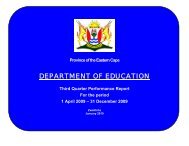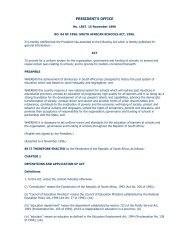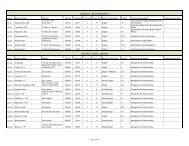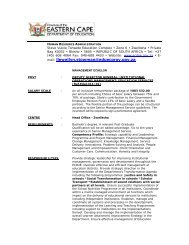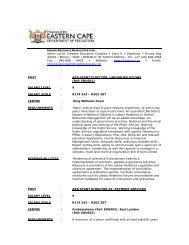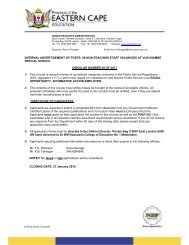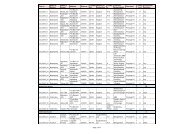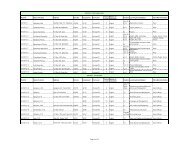School Community Integration Pilot Project - Department of Education
School Community Integration Pilot Project - Department of Education
School Community Integration Pilot Project - Department of Education
You also want an ePaper? Increase the reach of your titles
YUMPU automatically turns print PDFs into web optimized ePapers that Google loves.
A comparative analysis <strong>of</strong> education expenditure in Eastern Cape schools – November 2004<br />
relative cuts in the provincial allocation to education and the current and future<br />
funding pressures set out at the start <strong>of</strong> this report, there is a clear case for<br />
reprioritising resources.<br />
• Pursuit <strong>of</strong> a low LER in the province has achieved the goal <strong>of</strong> relatively<br />
favourable post provisioning in most districts <strong>of</strong> the province. The time has<br />
now come to reprioritise resources in favour <strong>of</strong> other vital areas <strong>of</strong> the<br />
education process.<br />
Personnel, recurrent and capital expenditure<br />
• The large number <strong>of</strong> small schools in the province create a pressure to<br />
increase the educator establishment due to their low LERs.<br />
• The post provisioning model allocates posts especially to small schools,<br />
schools with a large number <strong>of</strong> grades and combined schools, creating<br />
pressure for a large establishment in the context <strong>of</strong> the Eastern Cape.<br />
• The province has been able to meet national norms in the provision <strong>of</strong> learner<br />
support materials (LSM). It is however below the average per capita spending<br />
on non-personnel non-capital expenditure per capita and well below draft per<br />
capita norms for NPNC.<br />
• Capital expenditure on school infrastructure has increased rapidly in recent<br />
years. Based on available figures the Eastern Cape will be able to meet its<br />
target <strong>of</strong> eliminating infrastructure backlogs over the next ten years.<br />
Realigning schools for quality education<br />
• There is a strong case for realigning the public school system to address<br />
these issues by implementing a full primary (grades R to 7) and full secondary<br />
(grades 8 to 12) system throughout the province. A number <strong>of</strong> educational<br />
benefits would result from this realignment <strong>of</strong> the schooling system.<br />
• The change <strong>of</strong> combined schools to primary schools would reduce the very<br />
wide age spread within these schools, an important consideration with the<br />
prevalence <strong>of</strong> over aged learners in schools. This would make management<br />
<strong>of</strong> these schools easier and contribute to social cohesion within the school.<br />
• The change <strong>of</strong> combined schools to secondary schools would also reduce<br />
pressure on classroom space in a system that already suffers from acute<br />
over-crowding and backlogs. 7 rather than 9 grades would be using the same<br />
number <strong>of</strong> classrooms.<br />
• In senior secondary schools currently, educators are teaching 10 to 12<br />
subjects over only three grades in schools <strong>of</strong> acute classroom shortage. The<br />
practical result is <strong>of</strong>ten that each grade is taught one subject at a time in an<br />
overcrowded classroom, especially in small schools, with the educator moving<br />
between classrooms for different subjects. As the educator is only teaching a<br />
subject to three grades, high proportions <strong>of</strong> educator time are wasted through<br />
a low period load. This explains the seemingly paradoxical findings that LERs<br />
in senior secondary schools are very low, while educators report teaching<br />
very large class sizes <strong>of</strong> 50 or more in secondary schools.<br />
• Moving to a full secondary school system would enable much better utilisation<br />
<strong>of</strong> educators in the former Transkei. Larger secondary schools would be able<br />
to ‘cluster’ resources, <strong>of</strong>fering a wider subject choice and achieving<br />
49



